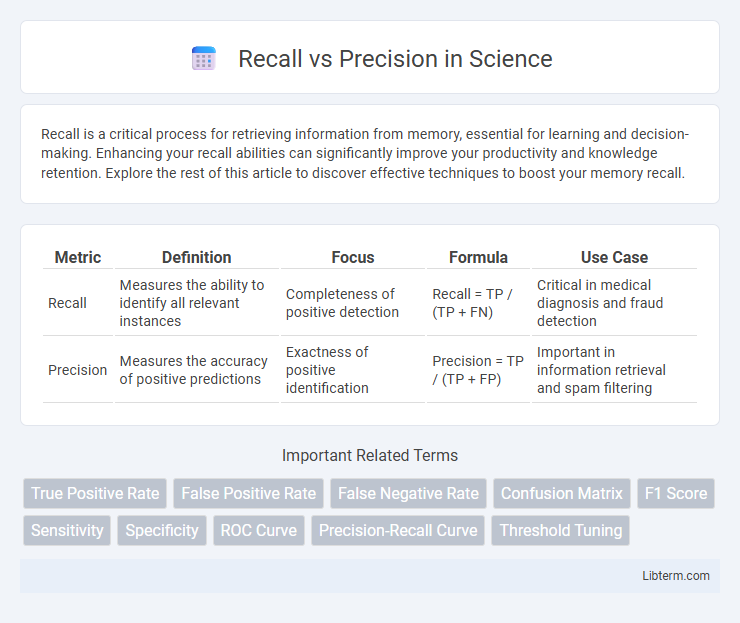Recall is a critical process for retrieving information from memory, essential for learning and decision-making. Enhancing your recall abilities can significantly improve your productivity and knowledge retention. Explore the rest of this article to discover effective techniques to boost your memory recall.
Table of Comparison
| Metric | Definition | Focus | Formula | Use Case |
|---|---|---|---|---|
| Recall | Measures the ability to identify all relevant instances | Completeness of positive detection | Recall = TP / (TP + FN) | Critical in medical diagnosis and fraud detection |
| Precision | Measures the accuracy of positive predictions | Exactness of positive identification | Precision = TP / (TP + FP) | Important in information retrieval and spam filtering |
Understanding Recall and Precision
Recall measures the proportion of actual positive cases correctly identified by a model, emphasizing the ability to capture all relevant instances. Precision evaluates the accuracy of the positive predictions, reflecting the ratio of true positives to all predicted positives. Understanding recall and precision is crucial for balancing false negatives and false positives in classification tasks.
Defining Recall in Machine Learning
Recall in machine learning measures the proportion of true positive predictions out of all actual positive instances, reflecting the model's ability to identify relevant cases. High recall indicates fewer false negatives, ensuring that most positive samples are detected by the algorithm. This metric is critical in applications where missing positive cases, such as disease detection or fraud identification, carries significant consequences.
Defining Precision in Machine Learning
Precision in machine learning measures the accuracy of positive predictions by calculating the ratio of true positive results to the total predicted positives, emphasizing the quality of relevant data retrieved. High precision indicates a low false positive rate, making it critical in applications like email spam filters and medical diagnosis where false alarms can be costly. Precision is mathematically defined as: Precision = True Positives / (True Positives + False Positives).
Key Differences Between Recall and Precision
Recall measures the ability of a model to identify all relevant instances by calculating the ratio of true positives to the sum of true positives and false negatives, emphasizing completeness. Precision quantifies the accuracy of positive predictions by dividing true positives by the sum of true positives and false positives, highlighting exactness. The key difference lies in recall prioritizing the retrieval of relevant items, while precision focuses on minimizing false positives.
The Importance of Recall in Classification Tasks
Recall measures the ability of a classification model to identify all relevant instances, making it critical in applications like medical diagnosis and fraud detection where missing positive cases can lead to severe consequences. High recall ensures fewer false negatives, thus improving the detection rate of rare but significant events. Prioritizing recall helps optimize sensitivity, ensuring that nearly all true positive cases are captured despite the potential increase in false positives.
The Importance of Precision in Classification Tasks
Precision measures the accuracy of positive predictions in classification tasks by calculating the ratio of true positives to the total predicted positives. High precision is crucial in applications such as medical diagnosis or fraud detection, where false positives can lead to costly or harmful consequences. Optimizing precision ensures that the model reliably identifies relevant instances while minimizing errors that could disrupt critical decision-making processes.
Balancing Recall and Precision: Trade-offs
Balancing recall and precision involves managing the trade-offs between identifying as many relevant instances as possible (high recall) and minimizing false positives (high precision). Increasing recall often reduces precision because more irrelevant results are included, while enhancing precision can decrease recall by excluding relevant data. Optimizing this balance depends on the specific application context, such as medical diagnosis prioritizing recall to avoid missing cases or spam detection emphasizing precision to reduce false alarms.
Practical Applications: When to Prioritize Recall
Prioritizing recall is crucial in medical diagnostics where missing a positive case could lead to severe consequences, such as undetected cancer screenings or infectious disease identification. In fraud detection systems, emphasizing recall ensures that most fraudulent transactions are flagged, minimizing financial losses despite an increased number of false positives. High recall is also essential in legal document review processes, where identifying all relevant documents is critical to avoid missing key evidence.
Practical Applications: When to Prioritize Precision
In medical diagnostics, prioritizing precision reduces false positives, preventing unnecessary treatments and patient anxiety. Fraud detection systems emphasize precision to minimize legitimate transactions flagged as suspicious, maintaining customer trust. In email spam filters, high precision ensures important emails are not mistakenly marked as spam, preserving important communication channels.
Measuring and Improving Recall and Precision
Recall measures the ability of a model to identify all relevant instances by calculating the proportion of true positives among the actual positives, while precision evaluates the accuracy of positive predictions by measuring the proportion of true positives among the predicted positives. Improving recall often involves reducing false negatives through techniques such as adjusting classification thresholds, using more representative training data, or enhancing feature extraction. Enhancing precision requires minimizing false positives by refining model parameters, implementing stricter decision boundaries, or incorporating more discriminative features to ensure accurate positive predictions.
Recall Infographic

 libterm.com
libterm.com